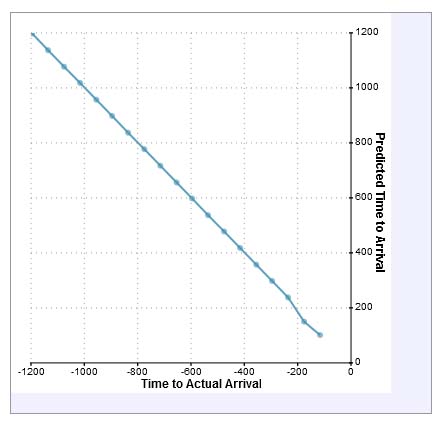There’s been a lot of anecdotal complaints about the accuracy of the Nextbus system we use to display Streetcar arrivals. While I find it useful for the way I use the system (I walk until a Streetcar catches up to me), I set out to gather some data. So for a couple of weeks I had the same routine that pulls data from Nextbus for the Transit Surfer do some data capture. I picked one stop (NW 10th and Couch) and had it record predictions once per minute.
This is a limited check, there’s no independent verification of when the vehicles arrive, all we can do with the data is compare how the predictions track over the course of a trip. So that’s what I did. We assume that the final prediction before the arrival is correct and use it to establish the time of arrival. We can then compare the prior predictions against the time they were recorded to see how accurate they are. Hint: there are some problems.
My fundamental conclusion is that Nextbus’ calibration algorithm is not dealing well with the time of day variations in Streetcar’s rate of progress.
I’ve shared the data with Streetcar management and I suspect it will be a topic of conversation with Nextbus. But I wonder if we want to re-evaluate our strategy? Would it be better to display the location of the next vehicle (e.g., 10th and Yamhill) rather than a time prediction? Would that be more informative or more useful in making choices?



7 responses to “Re-examining Nextbus”
I got a call from a certain journalist for a certain paper that had reported complaints about Nextbus that were very vocally dismissed on this site.
What can I say? Touché :-)
How often is it wrong? I mean, does it make a good prediction, (within 10%) how often, vs not within 10% how often?
I mean, off by a minute here or there is kind of to be expected, (since it doesn’t say coming in 3.36 minutes anyways,) and if at 5pm the system gets all weird, and then clears itself out at 5:15, that isn’t that big of a deal, but if it is off by 4 minutes every afternoon for a couple hours in a row…
I’m looking for some good visualization tools to express the range of error (anybody know any software that draws error bars well?), but in the afternoon, the system appears to generally be optimistic by several minutes at the when making predictions that about arrivals that are more than 10 minutes way.
I’ve shared the data with Streetcar management and I suspect it will be a topic of conversation with Nextbus. But I wonder if we want to re-evaluate our strategy? Would it be better to display the location of the next vehicle (e.g., 10th and Yamhill) rather than a time prediction? Would that be more informative or more useful in making choices?
Display of where the streetcar is would be VASTLY more useful than a time estimate. Kind of like the actual NextBus display provided via the Java App in a browser. I don’t know how that would be provided at a remotely reasonable price though.
But I wonder if we want to re-evaluate our strategy? Would it be better to display the location of the next vehicle (e.g., 10th and Yamhill) rather than a time prediction? Would that be more informative or more useful in making choices?
It is great for the locals who know what the information means. The vehicle location would not be as helpful for people who may not be familiar with the route (visitors, suburbanites, etc), and in these cases the ETA makes more sense.
But I wonder if we want to re-evaluate our strategy? Would it be better to display the location of the next vehicle (e.g., 10th and Yamhill) rather than a time prediction? Would that be more informative or more useful in making choices?
It is great for the locals who know what the information means. The vehicle location would not be as helpful for people who may not be familiar with the route (visitors, suburbanites, etc), and in these cases the ETA makes more sense.
“Would it be better to display the location of the next vehicle (e.g., 10th and Yamhill) rather than a time prediction?”
I guess I’m curious what the advantage of that information is, over a bad prediction. I mean, if the system is running, (i.e. it isn’t snowed closed or anything,) then knowing that the next streetcar is at 10th and Yamhill would mean that I’d have to make my own prediction about how long I should expect to wait, and my own prediction would probably be off by more than 30% in your example…